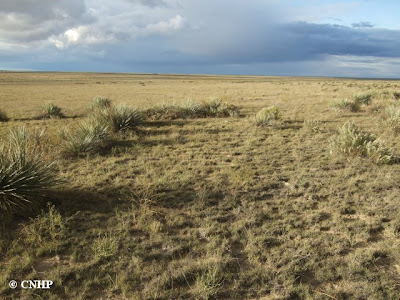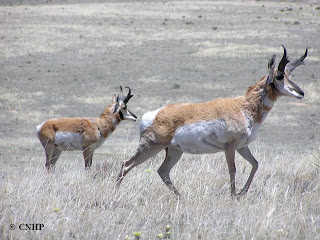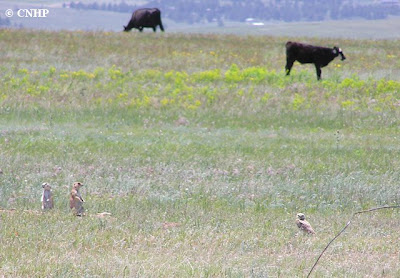This ecological system once covered most of Colorado east of the mountain front. Today, nearly 50% of our historic shortgrass prairie has been converted to agriculture or other uses - the largest loss of all of Colorado's ecosystems. In the early 1800s the shortgrass prairie was home to massive herds of free-ranging bison and pronghorn, as well as huge prairie dog colonies, deer and elk, and top predators including gray wolves and grizzly bears. Today, the most conspicuous animals on the prairie are domestic cattle. Pronghorn and prairie dogs still inhabit Colorado's prairies in reduced numbers, and the former top predators have been replaced by coyotes. Large-scale ecological processes such as climate, fire, and grazing by large animals exert strong influences in this ecosystem. Consequently, the short grasses that dominate this ecosystem are have evolved to be extremely tolerant of drought and grazing.
The pronghorn (Antilocapra americana) - survivors on the plains.
Prairie dogs, burrowing owl, and cows share the same landscape.
Many of Colorado's declining animal species are associated with the shortgrass prairie. Grassland bird species may constitute one of the fastest declining vertebrate populations in North America. The federally endangered black-footed ferret was lost to Colorado's shortgrass prairie prior to re-introduction of experimental populations in recent years. Species of conservation concern that still inhabit native prairie habitats in Colorado include: burrowing owl, ferruginous hawk, mountain plover, McCown's longspur, chestnut-collared longspur, and long-billed curlew, as well as northern pocket gopher, ornate box turtle, massasauga rattlesnake, and Texas horned lizard. The rarest plants in the shortgrass prairie are associated with isolated shale barren outcrops.
The Texas horned lizard (Phrynosoma cornutum).
Unlike the high elevation ecosystems such as spruce-fir and alpine tundra, shortgrass prairie lands are almost all in private ownership. Even so, some very large expanses of native prairie in good condition still exist, thanks to the stewardship of our ranching families. Unfortunately, in the absence of formal, legal protection (such as conservation easements), long-term tenure of private lands is not secure. Ongoing impacts to this landscape include renewable and non-renewable energy production (wind, solar, geothermal, oil and gas, and biofuels) and the continuing expansion of urban and exurban communities, especially along the Front Range.
Overall biodiversity, threat, and protection status scores for shortgrass prairie in Colorado.
A "windrose" graph depicting shortgrass prairie status for individual scoring factors.









No comments:
Post a Comment
Thanks for your comment!
Please note that all comments are moderated, so there may be a delay of some hours (especially over the weekend or at night Colorado time) before your comment shows up.